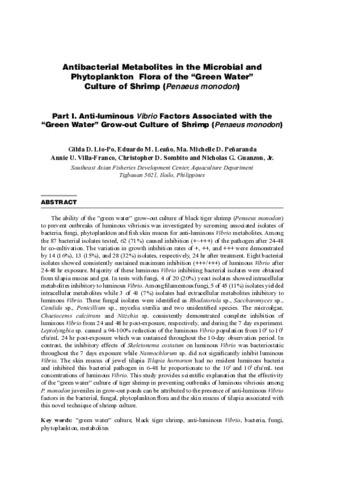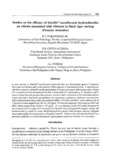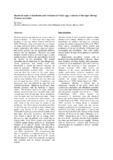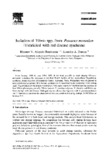Antibacterial metabolites in the microbial and phytoplankton flora of the "green water" culture of shrimp (Penaeus monodon): Part I. Anti-luminous vibrio factors associated with the "green water" grow-out culture of shrimp (Penaeus monodon)
- Global styles
- MLA
- Vancouver
- Elsevier - Harvard
- APA
- Help

Date
2005-03Author
Page views
4,312ASFA keyword
AGROVOC keyword
Taxonomic term
Metadata
Show full item recordShare
Abstract
The ability of the “green water” grow-out culture of black tiger shrimp (Penaeus monodon) to prevent outbreaks of luminous vibriosis was investigated by screening associated isolates of bacteria, fungi, phytoplankton and fish skin mucus for anti-luminous Vibrio metabolites. Among the 87 bacterial isolates tested, 62 (71%) caused inhibition (+~+++) of the pathogen after 24-48 hr co-cultivation. The variation in growth inhibition rates of +, ++, and +++ were demonstrated by 14 (16%), 13 (15%), and 28 (32%) isolates, respectively, 24 hr after treatment. Eight bacterial isolates showed consistently sustained maximum inhibition (+++/+++) of luminous Vibrio after 24-48 hr exposure. Majority of these luminous Vibrio inhibiting bacterial isolates were obtained from tilapia mucus and gut. In tests with fungi, 4 of 20 (20%) yeast isolates showed intracellular metabolites inhibitory to luminous Vibrio. Among filamentous fungi, 5 of 45 (11%) isolates yielded intracellular metabolites while 3 of 41 (7%) isolates had extracellular metabolites inhibitory to luminous Vibrio. These fungal isolates were identified as Rhodotorula sp., Saccharomyces sp., Candida sp., Penicillium sp., mycelia sterilia and two unidentified species. The microalgae, Chaetoceros calcitrans and Nitzchia sp. consistently demonstrated complete inhibition of luminous Vibrio from 24 and 48 hr post-exposure, respectively, and during the 7 day experiment. Leptolyngbia sp. caused a 94-100% reduction of the luminous Vibrio population from 104 to 101 cfu/mL 24 hr post-exposure which was sustained throughout the 10-day observation period. In contrast, the inhibitory effects of Skeletonema costatum on luminous Vibrio was bacteriostatic throughout the 7 days exposure while Nannochlorum sp. did not significantly inhibit luminous Vibrio. The skin mucus of jewel tilapia Tilapia hornorum had no resident luminous bacteria and inhibited this bacterial pathogen in 6-48 hr proportionate to the 103 and 105 cfu/mL test concentrations of luminous Vibrio. This study provides scientific explanation that the effectivity of the “green water” culture of tiger shrimp in preventing outbreaks of luminous vibriosis among P. monodon juveniles in grow-out ponds can be attributed to the presence of anti-luminous Vibrio factors in the bacterial, fungal, phytoplankton flora and the skin mucus of tilapia associated with this novel technique of shrimp culture.
Suggested Citation
Lio-Po, G. D., Leaño, E. M., Peñaranda, M. M. D., Villa-Franco, A. U., Sombito, C. D., & Guanzon, Jr., N. G. (2005). Antibacterial metabolites in the microbial and phytoplankton flora of the “green water” culture of shrimp (Penaeus monodon): Part I. Anti-luminous vibrio factors associated with the “green water” grow-out culture of shrimp (Penaeus monodon). In K. Nagasawa (Ed.), Recent Advances in Diagnosis and Prevention of Fish and Shrimp Diseases in Southeast Asia (pp. 169–177). Tigbauan, Iloilo, Philippines: Aquaculture Department, Southeast Asian Fisheries Development Center.
Type
Book chapterISBN
9718511732
Related items
Showing items related by title, author, creator and subject.
-
Studies on the efficacy of Sarafin® (sarafloxacin hydrochloride) on vibrios associated with vibriosis in black tiger shrimp (Penaeus monodon)
Pakingking, Rolando V., Jr. ; Lacierda, Erlinda; Torres, James L. (Fish Health Section, Asian Fisheries Society, 2002)
In vitro activity of Sarafin® (sarafloxacin hydrochloride) was determined against 7 luminous Vibrio harveyi isolates and 3 non-luminous Vibrio species (V. parahaemolyticus, V. alginolyticus and Vibrio species) isolated ...
; Lacierda, Erlinda; Torres, James L. (Fish Health Section, Asian Fisheries Society, 2002)
In vitro activity of Sarafin® (sarafloxacin hydrochloride) was determined against 7 luminous Vibrio harveyi isolates and 3 non-luminous Vibrio species (V. parahaemolyticus, V. alginolyticus and Vibrio species) isolated ... -
Bacterial loads in hatcheries and virulence of Vibrio spp. to larvae of the tiger shrimp Penaeus monodon
Torres, James L. (Bureau of Agricultural Research, Department of Agriculture, 2007)Shrimp hatcheries are high-density systems and are prone to diseases. A small-scale and a large-scale hatchery for the tiger shrimp Penaeus monodon in Iloilo, Philippines were monitored over two months for water quality ... -
Isolation of Vibrio spp. from Penaeus monodon (Fabricius) with red disease syndrome
From January 1990 to June 1993, 59% of the total juvenile to adult shrimp Penaeus monodon submitted for diagnosis at the Fish Health Section of the Aquaculture Department, Southeast Asian Fisheries Development Center, ...

 AQD Access
AQD Access




